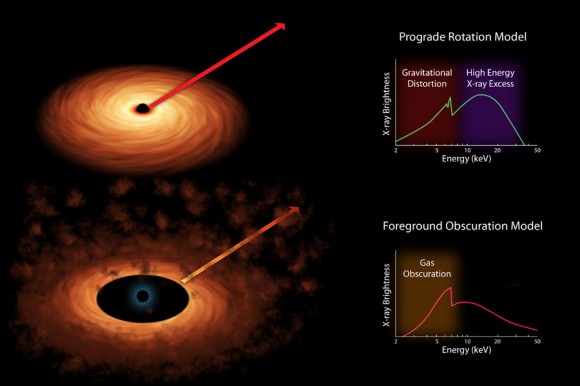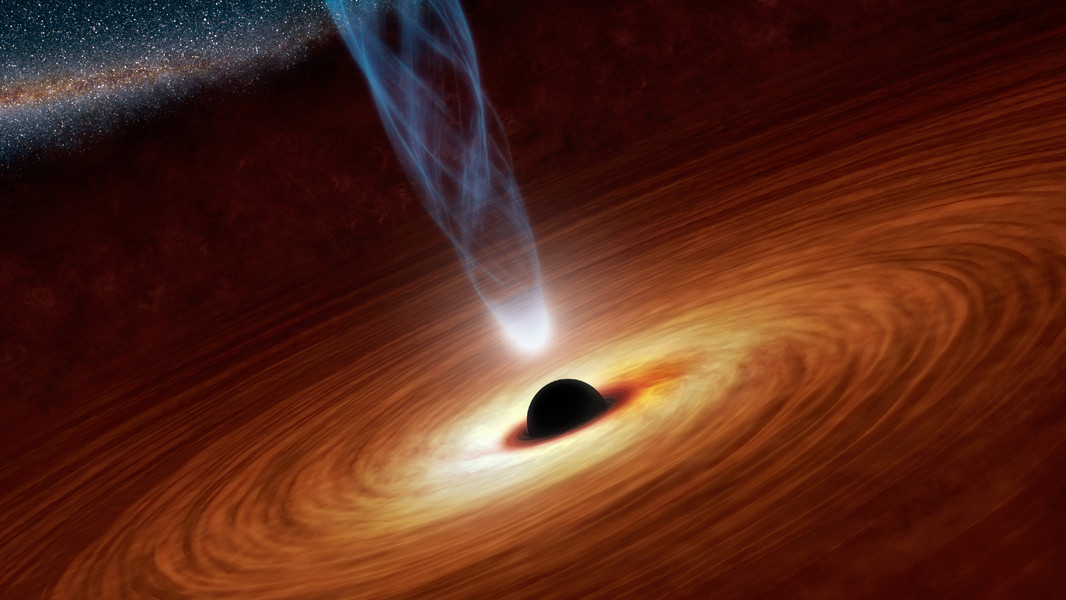Checking out the spin rate on a supermassive black hole is a great way for astronomers to test Einstein’s theory under extreme conditions – and take a close look at how intense gravity distorts the fabric of space-time. Now, imagine a monster … one that has a mass of about 2 million times that of our Sun, measures 2 million miles in diameter and rotating so fast that it’s nearly breaking the speed of light.
A fantasy? Not hardly. It’s a supermassive black hole located at the center of spiral galaxy NGC 1365 – and it is about to teach us a whole lot more about how black holes and galaxies mature.
What makes researchers so confident they have finally taken definitive calculations of such an incredible spin rate in a distant galaxy? Thanks to data taken by the Nuclear Spectroscopic Telescope Array, or NuSTAR, and the European Space Agency’s XMM-Newton X-ray satellites, the team of scientists has peered into the heart of NGC 1365 with x-ray eyes – taking note of the location of the event horizon – the edge of the spinning hole where surrounding space begins to be dragged into the mouth of the beast.
“We can trace matter as it swirls into a black hole using X-rays emitted from regions very close to the black hole,” said the coauthor of a new study, NuSTAR principal investigator Fiona Harrison of the California Institute of Technology in Pasadena. “The radiation we see is warped and distorted by the motions of particles and the black hole’s incredibly strong gravity.”
However, the studies didn’t stop there, they advanced to the inner edge to encompass the location of the accretion disk. Here is the “Innermost Stable Circular Orbit” – the proverbial point of no return. This region is directly related to a black hole’s spin rate. Because space-time is distorted in this area, some of it can get even closer to the ISCO before being pulled in. What makes the current data so compelling is to see deeper into the black hole through a broader range of x-rays, allowing astronomers to see beyond veiling clouds of dust which only confused past readings. These new findings show us it isn’t the dust that distorts the x-rays – but the crushing gravity.

“This is the first time anyone has accurately measured the spin of a supermassive black hole,” said lead author Guido Risaliti of the Harvard-Smithsonian Center for Astrophysics (CfA) and INAF — Arcetri Observatory.
“If I could have added one instrument to XMM-Newton, it would have been a telescope like NuSTAR,” said Norbert Schartel, XMM-Newton Project Scientist at the European Space Astronomy Center in Madrid. “The high-energy X-rays provided an essential missing puzzle piece for solving this problem.”
Even though the central black hole in NGC 1365 is a monster now, it didn’t begin as one. Like all things, including the galaxy itself, it evolved with time. Over millions of years it gained in girth as it consumed stars and gas – possibly even merging with other black holes along the way.
“The black hole’s spin is a memory, a record, of the past history of the galaxy as a whole,” explained Risaliti.
“These monsters, with masses from millions to billions of times that of the sun, are formed as small seeds in the early universe and grow by swallowing stars and gas in their host galaxies, merging with other giant black holes when galaxies collide, or both,” said the study’s lead author, Guido Risaliti of the Harvard-Smithsonian Center for Astrophysics in Cambridge, Mass., and the Italian National Institute for Astrophysics.
This new spin on black holes has shown us that a monster can emerge from “ordered accretion” – and not simply random multiple events. The team will continue their studies to see how factors other than black hole spin changes over time and continue to observe several other supermassive black holes with NuSTAR and XMM-Newton.
“This is hugely important to the field of black hole science,” said Lou Kaluzienski, NuSTAR program scientist at NASA Headquarters in Washington, D.C. “NASA and ESA telescopes tackled this problem together. In tandem with the lower-energy X-ray observations carried out with XMM-Newton, NuSTAR’s unprecedented capabilities for measuring the higher energy X-rays provided an essential, missing puzzle piece for unraveling this problem.”
Original Story Source: JPL/NASA News Release.


It is interesting how these observations are so close to the horizon. There will be of course gravitational Doppler effects near the horizon. A small interval of time a distant observer sees of a clock near the horizon dt is related to the interval of time the observer has on his watch, ?t’, by ?t’ = sqrt{1 – 2GM/rc^2}?t, for G = Newton constant of gravity, M the mass of the gravitating body or black hole c = speed of light and r the distance the observed clock is from the coordinate center of the black hole. For the sake of simplicity I am assuming the black hole is nonrotating or a Schwarzschild geometry. If this distant observer can measure clocks near the horizon the gravitational time dilation is related to the Doppler shift. A source of photons with some frequency is a clock, for the reciprocal of the frequency is time. It is a remarkable achievement to be able to filter out the spectra of radiation emitted close to the event horizon.
A typical black hole has horizons r_+ and r_- with r_+ > r_-. This is given by a BPS charge or angular momentum with r_{+/-} = m +/- sqrt{m^2 – a^2}, where here a = Q can represent an electric charge or any gauge charge and for a = J = angular momentum in the case of the Kerr metric and so forth. The “eternal black hole” as the pure mathematical solution also has a singularity in the interior. The Kerr metric has the singularity in a ring configuration. The region between r_+ and r_- is a spacelike trapping region, where light cones direct geodesics to r_- as a future surface — it is unavoidable. The region r < r_- is timelike with closed timelike curves. The singularity is also repelling. Gravity in a sense flips its role in this region. Then one can ask the question; if all the mass of the BH is in this ring singularity and it is repellant, how did it form? The solution is a mathematical construction and should not be taken as literal. In addition, the inner horizon r_- can be shown to have a "pile up" of geodesics, in particular null geodesics, that are blue shifted. So anyone falling into the BH will pass a divergent UV collection of fields there, which means in a physical sense r_- serves as the singularity. The region r r_+. The extremal black hole is compared classically to the third law of thermodynamic condition T = 0, which is not accessed. However, QM shows that Bose-Einstein (BE) condensates exist, which define a minimum temperature. Quantum black holes in their extremal condition are analogous to BE condensates, and these are for q-BHs should exist. Though one should not expect macroscopic BHs to become extremal. Just as with BE condensates with a small T > 0 defined by the Riemann zeta function from the Bose-Einstein statistics, a quantum black hole should be extremal for a tiny T > 0, and these temperatures approach zero as T — > 0 as m — > ?, or the number of states on the horizon becomes large. So a stellar mass BH should not be extremal or the probability for it is vanishingly small.
LC
OK, somebody has to as this… If: this black hole/singularity is rotating at “nearly breaking the speed of light” does that mean they measured this speed nearly at the equator?
Nice to see NuSTAR delivering such crucial data already within a year (launch June -12: http://en.wikipedia.org/wiki/NuSTAR ), illuminating black holes as it were.
I believe soon we will understand how intermediate black hole mass grows. Soon hopefully we will understand how ordinary stellar mass black holes do/could feed at such high rates. Great to be alive seeing how creation motors on.
Me